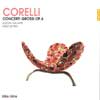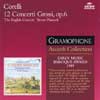Corelli Concerti Grossi Op 6
Pinnock’s set stands the test of time in this high-spirited, collaborative music
View record and artist detailsRecord and Artist Details
Composer or Director: Arcangelo Corelli
Genre:
Orchestral
Label: têteàtête
Magazine Review Date: 5/2004
Media Format: CD or Download
Media Runtime: 121
Mastering:
Stereo
DDD
Catalogue Number: OP20012

Tracks:
| Composition | Artist Credit |
|---|---|
| (12) Concerti Grossi |
Arcangelo Corelli, Composer
Arcangelo Corelli, Composer Europa Galante Fabio Biondi, Conductor |
Composer or Director: Arcangelo Corelli
Label: Harmonia Mundi
Magazine Review Date: 5/2004
Media Format: CD or Download
Media Runtime: 147
Mastering:
Stereo
Catalogue Number: HMX2901406

Tracks:
| Composition | Artist Credit |
|---|---|
| (12) Concerti Grossi |
Arcangelo Corelli, Composer
Arcangelo Corelli, Composer Chiara Banchini, Conductor Ensemble 415 |
Composer or Director: Arcangelo Corelli
Genre:
Orchestral
Label: Gramophone Awards Collection
Magazine Review Date: 5/2004
Media Format: CD or Download
Media Runtime: 130
Mastering:
Stereo
DDD
Catalogue Number: 474 907-2GGR2

Tracks:
| Composition | Artist Credit |
|---|---|
| (12) Concerti Grossi |
Arcangelo Corelli, Composer
(The) English Concert Arcangelo Corelli, Composer Trevor Pinnock, Conductor |
Author: Julie Anne Sadie
Ensemble 415, under Banchini and Christensen, takes a historically informed approach to the instrumentation and tempi, leaning heavily on the observations of Muffat and the employment records of Corelli’s patrons for evidence. This interpretation is representative, then, of the period in which the concertos were first performed – probably the 1680s – whereas Pinnock’s is an 18th-century one, reflective of the time in which they first appeared in print. Where Pinnock relies on a lean and lithe ensemble to convey crystal-clear textures, the violins of Ensemble 415 luxuriate on the cushioned sound created by six cellos, five contrebasses, four archlutes and a chitarrone, in addition to the ubiquitous harpsichord and organ. They also use them as soloists (for example in Concerto Nos 4 and 12) and for special effects, as in the Pastorale ad libitum of the Christmas Concerto to mimic the sounds of bagpipes and hurdygurdies, to great, if eccentric, effect.
While Banchini and her second violin, Enrico Gatti, offer exquisitely ornamented repeats, they also at times take disconcerting liberties with the tempi within movements (for example, at the cadences in the first allegro of the Christmas Concerto). Their allegro and vivace tempi are generally slower than Pinnock’s, and often agreeably so. Despite Georg Muffat’s report of Corelli’s preference for strongly contrasting tempi, I am inclined to believe that Pinnock often takes the fast movements too quickly. What is missing in 415’s performances is Pinnock’s architect-ural vision of these works and The English Concert’s irrepressible sense of joy.
The leader of Europa Galante, Fabio Biondi, takes a distinctly personal approach to what is in essence collaborative music. His own musical voice is omnipresent. He is the impetus for the outré attitude – the eccentric articulation and dynamics and the heavily elaborated ornamentation – that characterises this recording. One could almost be forgiven for thinking these were solo concertos (which begs the question, who was Corelli’s concertino second violinist?); to learn the identity of Biondi’s ‘second’ it is necessary to log onto Naïve’s website; no booklet accompanies this reissue.
By contrast, the relationship between the concertino and ripieno ensembles Corelli intended is celebrated by the musicians of The English Concert. The collaboration of Simon Standage, the late Micaela Comberti and Jaap ter Linden with their colleagues remains unparalleled in terms of its consistency and precision. While the engineers in these recordings may have influenced these impressions, their hand in the 415 recording is apparently restrained by the decision not to employ special miking; indeed, while the aural impression may be more lifelike, it is also less defined and, therefore, less brilliant.
Fifteen years after it was recorded, the glossy, corporate sheen of Pinnock’s interpretation remains undimmed, securing its place as one of the lasting icons of the British early-music revival, if not the wider movement.
Explore the world’s largest classical music catalogue on Apple Music Classical.
Included with an Apple Music subscription. Download now.

Gramophone Digital Club
- Digital Edition
- Digital Archive
- Reviews Database
- Full website access
From £8.75 / month
Subscribe
Gramophone Full Club
- Print Edition
- Digital Edition
- Digital Archive
- Reviews Database
- Full website access
From £11.00 / month
Subscribe
If you are a library, university or other organisation that would be interested in an institutional subscription to Gramophone please click here for further information.




